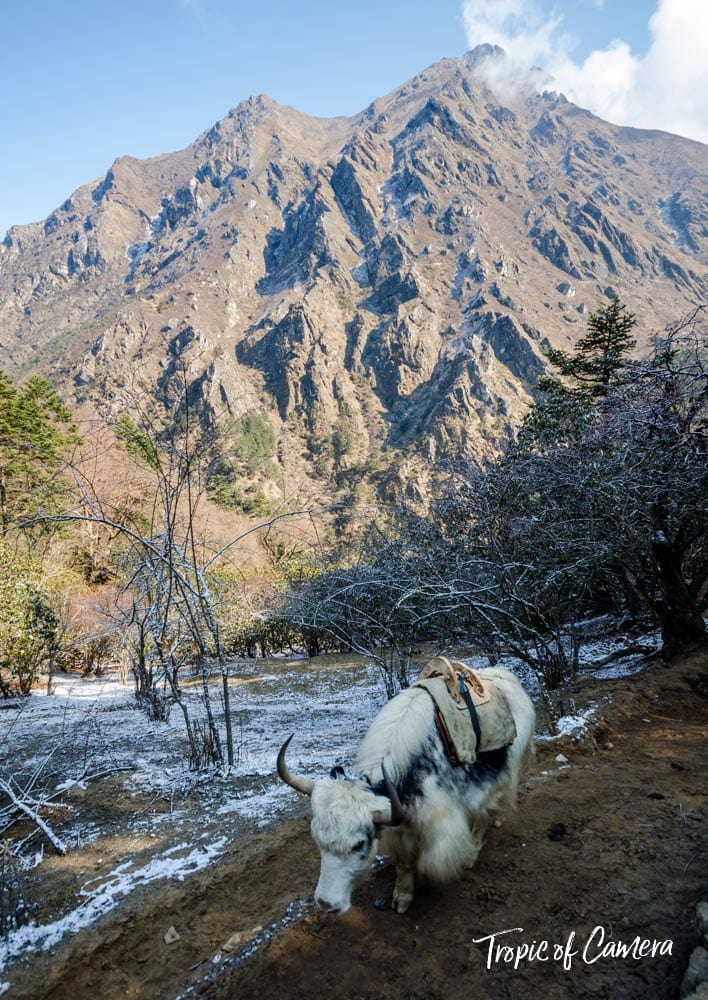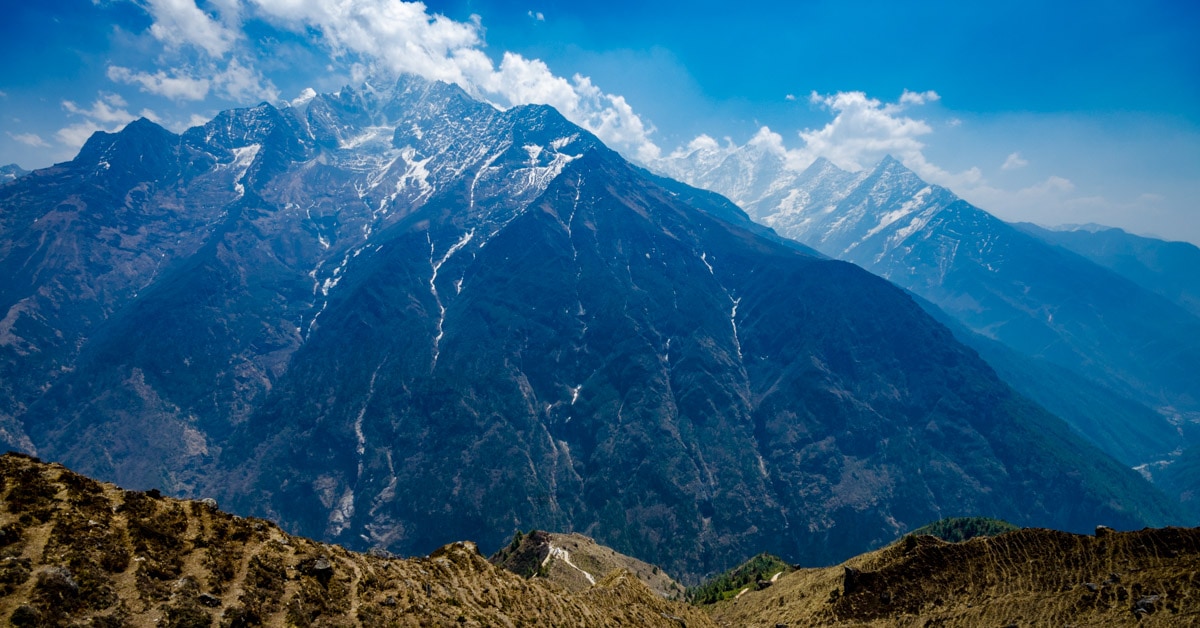The Himalayas are a location of exceptional beauty, attracting hundreds of travel and landscape photographers a year. One of the last rare places where vehicles cannot go, most travel is done on foot, providing photographers with unpolluted locations and local scenes. White-water rapids, dramatic cliffs and mountains, glaciers and yaks—it’s hard to take a bad photo of the Himalayas. But this mountainous region also brings with it unique photographic challenges. Here’s my top tips to take your photographs of the Himalayas to the next level.
Watch the brightness
The Himalayas are extremely bright because of the clear sky at altitude. This creates perfectly blue skies on a good day, but it messes with your auto-exposure readings as the white mountaintops can appear over-exposed. The sun reflected on the mountains is like shining a mirror into your camera. You can test this by taking a photo of the mountains and checking your histogram and exposure clipping in camera.
There are two ways to deal with the extreme brightness of the Himalayas. The first is to use exposure bracketing to dial down the exposure. By bracketing it down to -0.7 or -1.3, depending on the light, you can get a more accurate and balanced exposure.
The second is by using graduated neutral density filters. Graduated ND filters allow you to reduce the exposure in certain areas of the image, particularly useful for reducing the exposure of bright skies against dark foregrounds. I have Cokin rectangular plate glass filters which produce great results, but are a little fiddly especially when you’re wearing gloves and there are rocks below! I would recommend taking screw-in ND filters which you can keep attached to your camera while hiking.

Use a wide-angle lens
Forget Texas, everything is bigger in the Himalayas. You’re not going to get everything in with a standard mid-zoom lens. We are talking about the tallest mountains in the world here.
I use a Sigma 10-20mm f/4-5.6 to shoot wide angle scenes. Although I normally don’t recommend photographing everything on wide angle, once you get into the high mountains, it’s difficult not to. The overwhelming expansiveness of the Himalayas demands lenses to match. Try to use rocks and elements of the landscape to create a balanced foreground and background.
And go wild with the wide angle—landscapes aren’t the only thing you can photograph wide!
Check your battery life
Due to the cold weather, battery life often depletes more quickly. Although several people on my tour experienced this, my Nikon battery lasted the entire 17 day Everest Base Camp trek with no need for recharging. To combat battery depletion, many people recommend carrying spare batteries in your jacket’s inside pocket to keep them warm. These days, you can charge your battery in most tea houses along the way for around $3 an hour—but be warned, electricity prices get higher the higher you go!
Weight restrictions and travelling light

Because all flights in the Himalayas are on light 10 seater aircraft, the planes have strict weight restrictions. They weigh each bag individually and label it with the weight before getting on the plane. I was glad I invested in a carbon fibre tripod because it was an extra few kilos lighter than a standard aluminium tripod. You will need to consider and weigh each piece of equipment you take on the plane—not only for the plane flight but for your own ability to carry it when hiking.
In my day pack, I only had a body, 24-70mm f/2.8 lens, 10-20mm f/4-5.6 lens and camera charger. I made the judicious decision to leave my ND filters at the hotel which I would recommend taking next time. Remember, it’s not just the camera gear you have to carry—you’ll also need to take your wet weather/wind gear, snacks, hat, sunglasses and at least 2L of water. This added up to 7kgs, which was on the heavy end of day packs in our group of trekkers. If you have a good quality lightweight camera, I would seriously consider taking it instead of heavy camera gear, as once you reach altitude, you start to feel like a plodding turtle with all the gear on your back.
Take a tripod
While you won’t need to carry your tripod with you at all times, I included my carbon-fiber tripod in my main pack carried by a porter, so that I could take long exposures at night and sunrise/sunset. A lighter alternative is a small Gorillapod.

Choose a quality camera backpack
It’s important that the camera bag you take is tough, durable and most of all, comfortable to carry over long distances for extended periods of time. I used my Lowepro Fastpack 250, which suited the trip well, but there are plenty of other great trekking camera bags. Make sure the heaviest weight of your DSLR camera is positioned to fall on the hips and lower back, much like packing a larger bag for an outdoors trip. Your bag also needs space to carry a water bladder or bottles. A wet weather cover is another essential item; I got caught in a snow storm and the cover protected my camera gear from the extreme weather.
Do your research
Evidently, by reading this article you’re researching Himalayan photography. But did you know that you will not get a clear shot of Mt Everest unless you approach from the Chinese side? Or that from the Nepalese side, Mt Everest appears as a small obsidian tip next to Lhotse? To avoid disappointment, make a shot list and research how to get those images before you get there.

Respect the locals
Every time I travel, there’s always one guy who ignores this golden rule. While staying in teahouses you’re living in the heart of local villages. You’ll pass many people who are going about their daily business, much the same we would back home. Think before you take a photo, “would I appreciate it if someone took a photo of me doing that at home?” A lot of things like washing the laundry and bathing are public in the Himalayas. As much as it might seem “quaint”, would it really be that exciting taking a photo of you doing your laundry at home?
There are also several incredible monasteries in the Himalayas, such as Tengboche Monastery. These ancient places of worship have their own rules and regulations about photography and filming. Check with your guide or one of the monks before snapping away. For example, when I was watching a series of Buddhist prayer rituals, photography was not permitted, but after the prayer, the monks allowed photos to be taken.
Tours vs Guides
As a photographer, it’s beneficial to hire an individual guide and porter in Kathmandu, rather than join a guided tour group which has to meet deadlines. While I had a great time on my guided tour, if I did it again I’d hire an individual guide and porter. Not only is it cheaper, but you get to control the itinerary and pace. Psychologically, group tours affect photographers because you feel like you have to keep up with the group which rushes your shots. With an individual guide, it’s easy to spend an extra day in tea houses if you’d like to wait out the weather, take some more photos of a village or explore the area.
Want to see my best Himalaya photography? Check out the gallery and let me know what you think!



